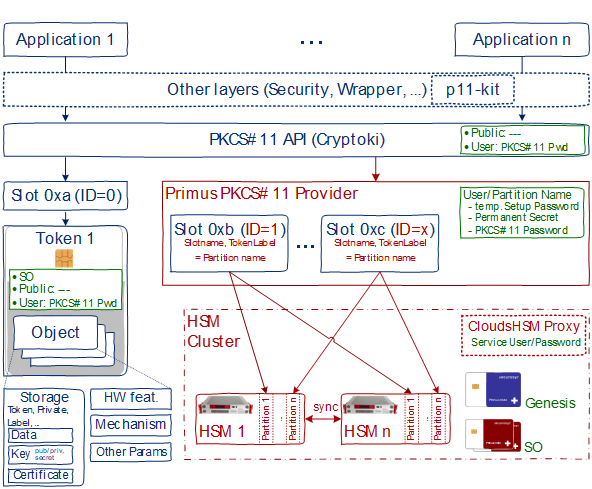Primus PKCS#11 API Provider
PKCS#11 is a standard that defines a platform-independent API for managing cryptographic objects, such as keys and certificates, and performing cryptographic operations, such as encryption and decryption.
The Primus PKCS#11 Provider handles the vendor specific configuration and communication with Primus HSM cluster(s). The following architecture diagram shows on the left side the legacy Smart Card architecture (blue) and on the right side the integration of the Primus PKCS#11 provider (red) and in green the authentication mechanisms.
PKCS#11 Architecture Overview and Primus PKCS#11 Provider integration
Network HSM and redundant clusters are not known by the PKCS#11 standard. Therefore, an HSM partition corresponds to a slot with inserted token, both having the name of the partition. Multiple partitions are referenced via different IDs. Redundant partitions (cluster) must have the same ID configured and are not visible for the applications.
An additional tool (ppin) is used to initialize secure communication with the HSM(s), to initially retrieve a permanent secret using the temporary setup password. The application API provides only the public access (e.g. listing public objects) or User access (e.g. using private objects) requiring the PKCS#11 password/pin. SO access is not supported.
While multiple applications per partition is supported by the PKCS #11 standard, it is the customer's responsibility to validate that applications sharing a partition do so in a manner that does not result in conflicts between the applications.
Securosys SA strongly recommends customers to implement periodic backups of the key material held within the HSM in a manner consistent with the value of the data being protected by them. It is critical to align this backup strategy with the application's key management behavior. For example, backups must be refreshed immediately after the application performs any key rotation activities; backups should also be refreshed before any application, provider or HSM upgrades are performed. This is particularly critical for data encryption applications, where loss of the keys renders the data inaccessible.
Primus HSMs provide different mechanisms like device and partition backup, key invalidation, manual cloning and HA-cloning which allow the reliable backup of such data for an HSM and/or synchronization within a cluster of HSMs. Please refer to the Primus HSM User Guide for more details on these features.
Backups and redundant setups should be verified on a regular basis both to ensure they are usable and to ensure the team responsible for the system knows how to use them to perform a recovery.
Securosys SA also recommends users to test thoroughly all application and HSM upgrades before deploying them on production systems. Depending on the customer's deployments behavior changes in the application or HSM may have an unexpected result.